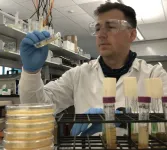Chemotherapy with light; only one injection required
Chemotherapy with only one injection, repeated phototherapy, and no side effects. Development of a cancer-targeted single component supramolecular peptide phototherapeutic agent
2021-01-14
(Press-News.org) Researchers in South Korea have developed a phototherapy technology that can significantly increase efficiency while reducing the pain of chemotherapy and minimizing side effects after treatment. The President of Korea Institute of Science and Technology (KIST), Seok-Jin Yoon announced that a research team led by Dr. Se-hoon Kim at the Theragnosis Research Center (KU-KIST Graduate School of Converging Science and Technology) has developed a cancer-targeted phototherapeutic agent that promises complete elimination of cancer cells without side effects. It involves only one injection and repeated phototherapy. This development was made through joint research with Professor Dong-June Ahn of Korea University and Professor Yoon-Sik Lee of Seoul National University.
Phototherapy technology, a cancer treatment modality that uses light, injects a photosensitizer that destroys cancer cells in response to a laser, which accumulates in only cancerous tissues. Further, it shoots light to selectively destroy the cancer cells. It has far fewer side effects than radiation therapy or general chemotherapy (that inevitably damage the tissues surrounding the cancer cells), allowing repeated treatment.
Whereas the effect of the conventional photosensitizers only lasted for one session, and the photosensitizer had to be administered each time the treatment procedure was repeated. Moreover, the residual photosensitizer after treatment accumulated in the skin or eyes causing side effects due to light; thus, it was recommended to isolate the patient from sunlight and indoor lighting for some time after treatment. Overall, the patients receiving treatment have had to suffer from the pain of the injection and the inconvenience of living in isolation each time. Recently, photosensitizers with phototherapeutic effects that get activated only in cancer tissues have been developed; however, they are still toxic and have to be injected for every repeat treatment.
Dr. Se-hoon Kim and his team at KIST used peptides that selectively target cancer tissues and assemble themselves in a specific order to resolve the problems associated with the phototherapy technology. The research team developed a peptide-based photosensitizer that activates phototherapeutic effects only in cancer tissues by using the internalizing RGD peptide (iRGD) that can selectively penetrate and target cancer tissues as the skeleton, and by properly designing a matting agent for the modulation of its reaction to light.
When this newly developed photosensitizer is injected into a living body, it is activated by the body temperature and aggregates into a supramolecular array designed by the research team, to be stored around cancer cells. The subsequent phototherapy can destroy only cancer cells without affecting normal cells.
The phototherapeutic agent developed by the researchers was injected into a mouse model implanted with a tumor, and the photosensitizer was stored around the tumor and was continuously released for a long time (2 to 4 weeks), demonstrating the ability of selectively targeting the tumor with just one injection around the cancerous tissues. Moreover, no toxicity was found to destroy the tissues and major organs around the cancer, even with repeated exposure to light. The cancerous tissues were completely removed through repeated procedures.
"We developed a cancer-targeting peptide phototherapeutic agent that forms a reservoir through supramolecular self-assembly without additional adjuvants when injected in vivo," said KIST Center Director Se-hoon Kim. "The developed phototherapeutic agent is expected to be useful in future phototherapy as it allows long-term repeated phototherapy without toxicity after only one injection around the cancer until the complete removal of the cancer, and has a simple formulation with a single component," he added.
INFORMATION:
This study was carried out with a grant from the Ministry of Science and ICT (MSIT), as part of the Institutional R&D Program of KIST. The results of this study were published in the latest issue of "ACS Nano" (IF: 14.588, the top 5.25% in JCR), an international journal in the field of nanotechnology.
[Attachments] See images for this press release:

ELSE PRESS RELEASES FROM THIS DATE:
2021-01-14
While there is an abundant amount of research about traumatic brain injuries in athletes and those serving in the military, the same data is scarce when it comes to concussions and head and neck injuries sustained due to intimate partner violence.
Carrie Esopenko, assistant professor in the Department of Rehabilitation and Movement Sciences in the Rutgers School of Health Professions says that the World Health Organization estimates that one in three women will experience intimate partner violence (IPV) in her lifetime, and studies suggest that anywhere between 30% to 90% of women who experience physical abuse at the hands of an intimate partner experience head trauma. Yet not enough data is being collected to understand how this head trauma affects cognitive and psychological ...
2021-01-14
Cities have become the focus of global climate mitigation efforts because as they are responsible for 60-70% of energy-related CO2 emissions. As the world is increasingly urbanized, it is crucial to identify cost-effective pathways to decarbonize and enhance the resilience of cities, which ensure the well-being of their dwellers. In this study, we propose a "SolarEV City" concept, in which integrated systems of cities' roof-top photovoltaics and electric vehicles (EVs) supply affordable and dispatchable CO2-free electricity to urban dwellers.
The SolarEV City assumes that 70% of toof-top of cities at maximum are used for PV and all passenger vehciles are converted to ...
2021-01-14
August 2020 set new record high sea surface temperatures (SSTs) in the northwestern Pacific Ocean and around the Japan coasts. A new study led by National Institute for Environmental Studies (NIES) researchers revealed that this warming record could not happen without human-induced climate changes.
The northwestern Pacific sea surface becomes warm seasonally around August every year. However, it was unprecedentedly high in August 2020, according to the Japan Meteorological Agency and the National Oceanic and Atmospheric Administration. The extremely high SSTs exceeding 30°C, which lasted until mid-September, may have intensified tropical cyclones such as ...
2021-01-14
At cruising altitude, airplanes emit a steady stream of nitrogen oxides into the atmosphere, where the chemicals can linger to produce ozone and fine particulates. Nitrogen oxides, or NOx, are a major source of air pollution and have been associated with asthma, respiratory disease, and cardiovascular disorders. Previous research has shown that the generation of these chemicals due to global aviation results in 16,000 premature deaths each year.
Now MIT engineers have come up with a concept for airplane propulsion that they estimate would eliminate 95 percent of aviation's NOx emissions, and thereby reduce the number of associated early deaths by 92 percent.
The concept is inspired ...
2021-01-14
Tsukuba, Japan -- We laugh when we see Homer Simpson falling asleep while driving, while in church, and while even operating the nuclear reactor. In reality though, narcolepsy, cataplexy, and rapid eye movement (REM) sleep behavior disorder are all serious sleep-related illnesses. Researchers at the University of Tsukuba led by Professor Takeshi Sakurai have found neurons in the brain that link all three disorders and could provide a target for treatments.
REM sleep correlates when we dream. Our eyes move back and forth, but our bodies remain still. This near-paralysis of muscles while dreaming is called REM-atonia, and is lacking in people with REM sleep behavior disorder. Instead ...
2021-01-14
Non-invasive imaging technique called 31-phosphorus magnetic resonance spectroscopy used to measure mitochondrial function in patients with motor neuron disease (MND)
Evidence shows that mitochondria - often referred to as the cell's battery - are impaired in MND
This technique could be used to measure the effectiveness of future treatments for MND
Researchers from the Sheffield Institute for Translational Neuroscience (SITraN) have used a new imaging technique to measure the function of mitochondria in patients with motor neuron disease (MND).
The research, published today (13 January 2021) ...
2021-01-14
Patients with type 2 diabetes who follow a strict low carbohydrate diet for six months may experience greater rates of remission compared with other recommended diets without adverse effects, suggests a study published by The BMJ today.
The researchers acknowledge that most benefits diminished at 12 months, but say doctors might consider short term strict low carbohydrate diets for managing type 2 diabetes, while actively monitoring and adjusting diabetes medication as needed.
Type 2 diabetes is the most common form of diabetes worldwide and diet is recognised as an essential part of treatment. But uncertainty remains about which diet to choose and previous studies have reported mixed results.
To address this evidence gap, a team of international researchers ...
2021-01-13
The build-up of calcium in a major artery outside of the heart could predict future heart attack or stroke, a new Edith Cowan University led study has demonstrated.
Published today in the Journal of the American Heart Association, the research could help doctors identify people at risk of cardiovascular disease years before symptoms arise.
Analysing 52 previous studies, the international team of researchers found that people who have abdominal aortic calcification (AAC) have a two to four times higher risk of a future cardiovascular event.
The study also found the more extensive the calcium in the blood vessel wall, the greater the risk of future cardiovascular events and people with AAC ...
2021-01-13
Decades of research show that depression, stress, loneliness, and poor health behaviors can weaken the body's immune system and lower the effectiveness of certain vaccines. A new report accepted for publication in Perspectives on Psychological Science suggests that the same may be true for the new COVID-19 vaccines that are in development and the early stages of global distribution. Fortunately, it may be possible to reduce these negative effects with simple steps like exercise and sleep.
Vaccines are among the safest and most effective advances in medical history, protecting society from a wide range of otherwise devastating diseases, including smallpox and polio. The key to their success, however, is ensuring that a critical percentage of the population is effectively ...
2021-01-13
Pulsed ultraviolet light can be an effective alternative to some of the antimicrobial technologies now used by the poultry industry to kill pathogens on eggshells, according to Penn State researchers, who simulated production conditions to test the technology.
Researcher Paul Patterson, professor of poultry science, College of Agricultural Sciences, suggests the technology has merit for commercial application in the egg industry.
"This study is unique because it scaled-up and applied components of standard egg processing to a conveyor and sanitizing eggs in a commercial setting," he said. "In the absence of water or other chemical sanitizers, this technology ...
LAST 30 PRESS RELEASES:
[Press-News.org] Chemotherapy with light; only one injection required
Chemotherapy with only one injection, repeated phototherapy, and no side effects. Development of a cancer-targeted single component supramolecular peptide phototherapeutic agent



